[RyanS, Jenne, all the other control room people, of whom there were many]
Summary: We can get to PREP_DC_READOUT_TRANSITION (at least once), but had trouble with OMC locking.
We tried some locking earlier in the day, first starting with doing the same trick as yesterday (alog 88432) and moving ITMX while ETM and TMS were controlled by green WFS to improve the COMM beatnote. However, I only ended up moving ITMX 0.3 urad in yaw. Because this was a small change and Sheila reminded me that we can lock (when the wind is low) with comm down at -10 dBm-ish, so I decided that next lock we'd just use the camera setpoints (which we did and was successful). During this time, we had to disable SRC1 and PRC1 in DRMI ASC because they were pulling the alignment away, and we weren't really on the POP QPDs at all. Anyhow, we got to PREP_ASC_FOR_FULL_IFO twice, but the alignment never looked excellent. We tried ENGAGE_ASC_FOR_FULL_IFO once, and it was really bad and killed the lock. The other time, we think that the seismic state changing from useism to windy caused us trouble (but, in retrospect, likely was only troublesome because the alignment was so poor).
We then realized that, after the big earthquakes from this weekend, our input pointing wasn't good. RyanS then set the IMs 1, 2, and 3 such that they matched their top mass osems (not necessarily their sliders). We then moved IM3 a little bit to get back to where we had been on IM4 Trans QPD before the power outage (pit of 0.239, yaw of -0.071). We were able to quite easily run through an initial alignment with this. During this and all subsequent initial alignments, we used the pre-power outage green setpoints (including cameras). The COMM beatnote was around -9 dBm, so that's pretty good.
Some time around here we had the -18 V failure, see alog 88446 for details.
Then, we did another initial alignment.
Then, the CDS team let us know that they needed to reboot all the models, see alog 88448 for details. After all the models were back, Ryan restarted the ALS_[X,Y]ARM guardians using "guardctrl restart NODE", so they would know how to start their AWGs in case SCAN_ALIGNMENT needs to be run.
We then restored sliders to just after one of our recent inital alignments, and Ryan then reset the IMs 1-3 to their top mass osems again, and again moved IM3 to get us back to the pre-power outage spot on IM4. ....And did yet another initial alignment.
After this, we finally were able to try to lock for the first time in several hours! And things went really, really quite well. We basically didn't touch anything at all (PRC1 and SRC1 still disabled in DRMI ASC), and were able to lock to PREP_FOR_DC_READOUT! Yes, you read that right, ENGAGE_ASC_FOR_FULL_IFO did just fine on its own. The buildups went down then came back again, so we were a bit scared, but it kept hold of everything and was able to converge. The PRM's ADS alignment took a loooonng time to converge, which we've seen before after a power outage (eg, alog 86944), so after all of the ASC was on (including SOFT_LOOPS) and converged, I reset the POP_A offsets, and Ryan accepted them in safe.snap.
(Later, after some relocks, we're able to use PRC1 in DRMI ASC now that its offsets have been set. But, still SRC1 is left out since it's pulling things away).
The violin modes are quite high, but not so bad that it's impossible to get 2W locked.
We went to PREP_DC_READOUT_TRANSITION, and noticed that we were having trouble locking the OMC. We're still not sure what's going on here, and we're going to leave it for the night. We're hoping to leave it at PREP_DC_READOUT_TRANSITION, however the second time that we did ENGAGE_ASC_FOR_FULL_IFO, something pulled us away and we lost lock. We'll let it try one more time.
OMC locking troubles and symptoms:
- In TUNE_OFFSETS, the first time it tried to measure the transfer function, the magnitude would be way wonky (like, 40k rather than ~1), but it wouldn't go past there because the phase was more than 30 deg from 0 or 180. It would then try again to measure the TF.
- The second time, it would often get a sensible number, and the phase was fine. However, since ErrorFlag had been set to True the first time around and it never got set back to False on the next try, it would just fail again and cycle through DOWN. I added lines to set ErrorFlag to False if the phase measured okay.
- We then started having troubles even getting it to lock on the carrier, although it looked like it found the carrier just fine, and had 16 mA on the DCPDs. It keeps saying "wrong mode?", even though the DCPDs were 16 mA.
- One time, I found the carrier by hand and manual-ed over FIND_CARRIER. However, the TUNE_OFFSETS kept giving phases of ~145 deg (which is more than 30 deg away from 180, and thus a failure). I copied in the scale_offset value that the guardian calculated though, and then manual-ed over TUNE_OFFSETS. We lost lock when I tried to have ISC_LOCK take us to DC_READOUT, but in retrospect that's probably due to not having done the prep items in the main state of TUNE_OFFSETS that set up the OMC-READOUT path.













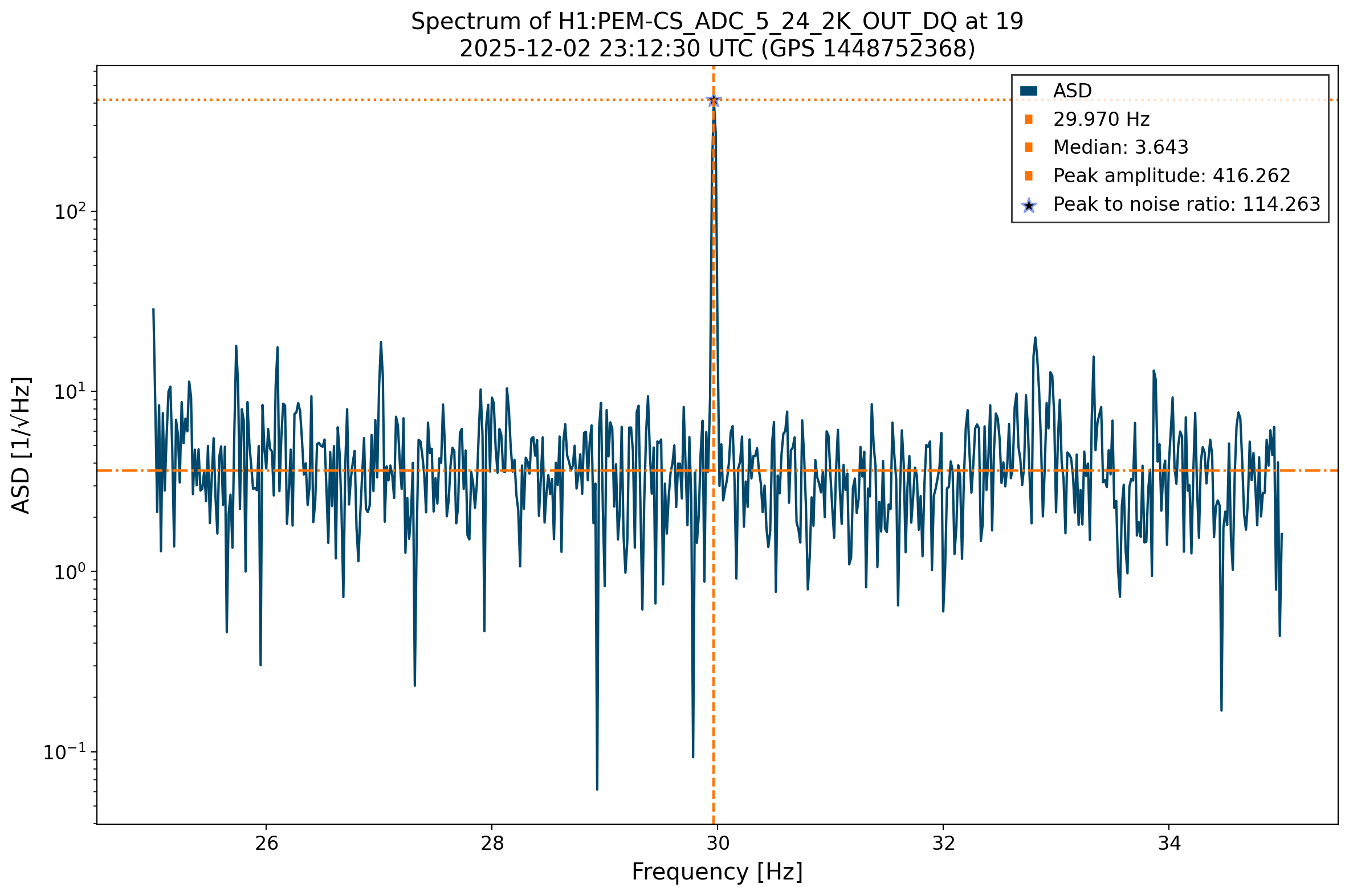 That is, we compute the ASD using 60s FT and check the amplitude of the ASD at the frequency of the first harmonic of the largest of the near-30 Hz combs, the fundamental at 29.9695 Hz. Then, we compute the median of the +- 5 surrounding Hz and save the ASD value at 29.9695 Hz "peak amplitude" and the ratio of the peak against the median to have a sort of "SNR" or "Peak to Noise ratio".
Note that we also check the permanent magnetometer channels. However, in order to compare them to the rest, we multiplied the ASD of the magnetometers that Robert gave us times a hundred so that all of them had units of Tesla.
After saving the data for all the positions, we have produced the following two plots. The first one shows the peak to noise ratio of all positions we have checked around the LVEA and the electronics room:
That is, we compute the ASD using 60s FT and check the amplitude of the ASD at the frequency of the first harmonic of the largest of the near-30 Hz combs, the fundamental at 29.9695 Hz. Then, we compute the median of the +- 5 surrounding Hz and save the ASD value at 29.9695 Hz "peak amplitude" and the ratio of the peak against the median to have a sort of "SNR" or "Peak to Noise ratio".
Note that we also check the permanent magnetometer channels. However, in order to compare them to the rest, we multiplied the ASD of the magnetometers that Robert gave us times a hundred so that all of them had units of Tesla.
After saving the data for all the positions, we have produced the following two plots. The first one shows the peak to noise ratio of all positions we have checked around the LVEA and the electronics room:
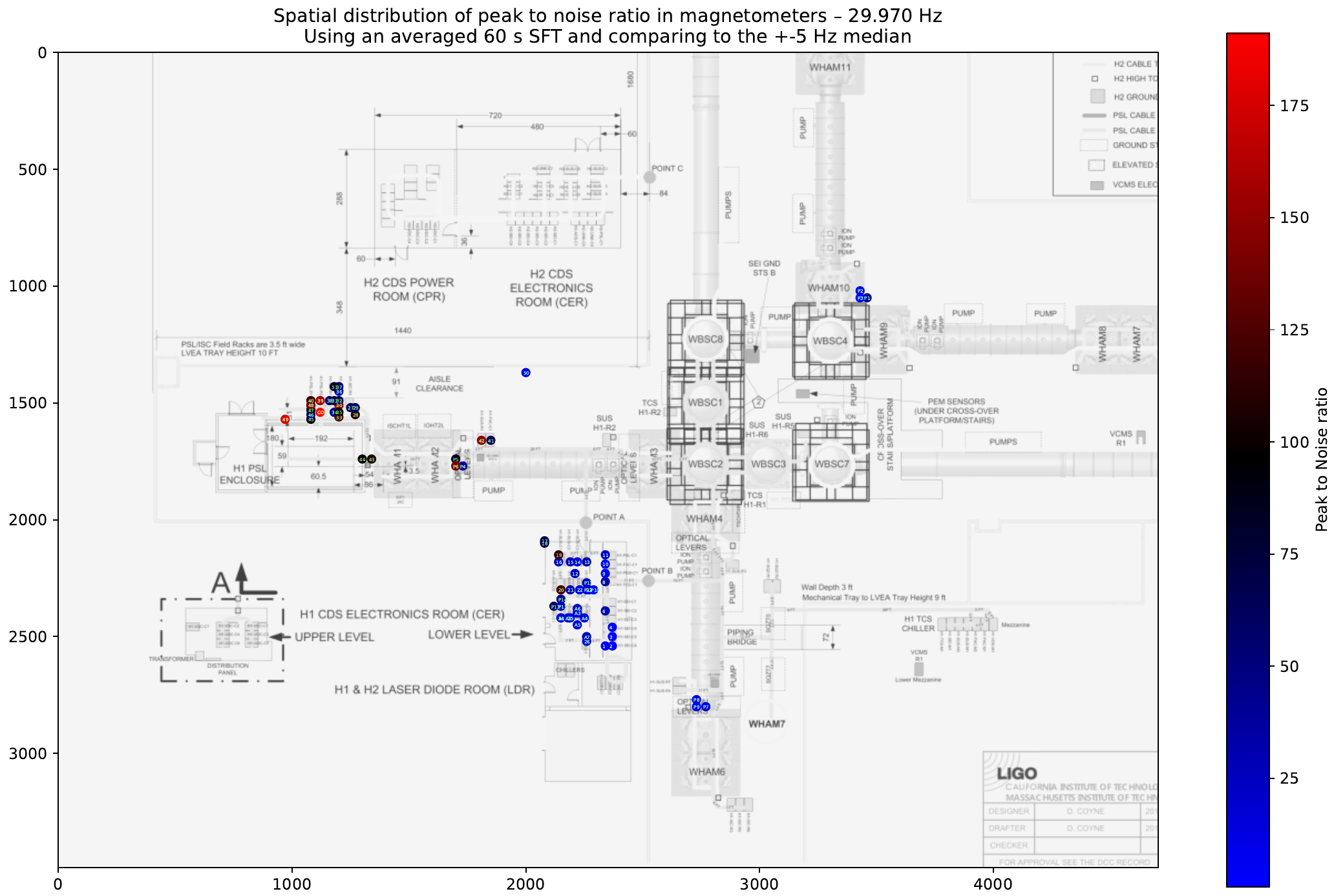 Where the X and Y axis are simply the image pixels. The color scale indicates the peak to noise ratio of the magnetometer in each position. The background LVEA has been taken from
Where the X and Y axis are simply the image pixels. The color scale indicates the peak to noise ratio of the magnetometer in each position. The background LVEA has been taken from 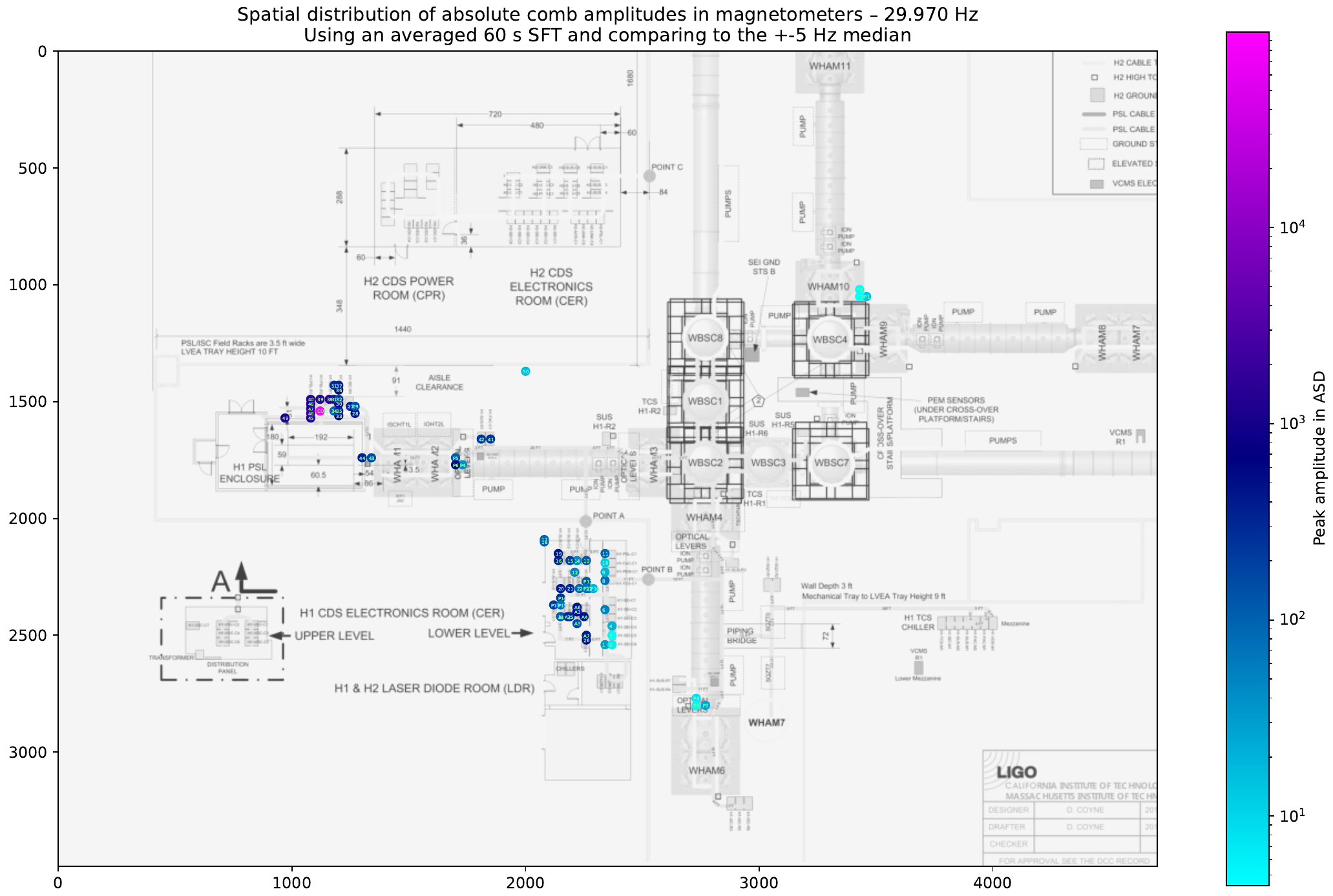 Note that in this figure, the color scale is logarithmic. It can be seen how, looking at the peak amplitudes, there is one particular position in the H1-PSL-R2 rack whose amplitude is around 2 orders of magnitude larger than the other positions. Note that this position also had the largest peak to noise ratio.
This position, that we have tagged as "Coil", is putting the magnetometer into a coil of white cables behind the H1-PSL-R2 rack, as shown in this image:
Note that in this figure, the color scale is logarithmic. It can be seen how, looking at the peak amplitudes, there is one particular position in the H1-PSL-R2 rack whose amplitude is around 2 orders of magnitude larger than the other positions. Note that this position also had the largest peak to noise ratio.
This position, that we have tagged as "Coil", is putting the magnetometer into a coil of white cables behind the H1-PSL-R2 rack, as shown in this image:
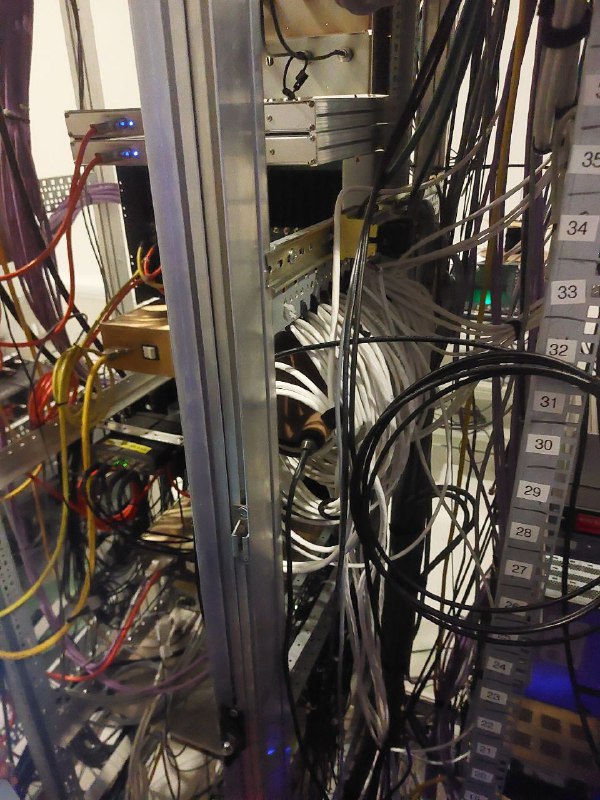 The reason that led us to put the magnetometer there is that we also found the peak amplitude to be around 1 order of magnitude larger than on any other magnetometer on top of one set of white cables that go from inside the room towards the rack and up towards we are not sure where:
The reason that led us to put the magnetometer there is that we also found the peak amplitude to be around 1 order of magnitude larger than on any other magnetometer on top of one set of white cables that go from inside the room towards the rack and up towards we are not sure where:
 This image shows the magnetometer on top of the cables on the ground behind the H1-PSL-R2 rack, the white ones on the top of the image appear to show the peak at its highest. It could be that the peak is louder in the coil because there being so many cables in a coil distribution will generate a stronger magnetic field.
This is the actual status of the hunt. These white cables might indicate that the source of these combs is the different interlocking system in L1 and H1, which has a chassis in the H1-PSL-R2 rack. However, we still need to track down exactly these white cables and try turning things on and off based on what we find in order to see if the combs dissapear.
This image shows the magnetometer on top of the cables on the ground behind the H1-PSL-R2 rack, the white ones on the top of the image appear to show the peak at its highest. It could be that the peak is louder in the coil because there being so many cables in a coil distribution will generate a stronger magnetic field.
This is the actual status of the hunt. These white cables might indicate that the source of these combs is the different interlocking system in L1 and H1, which has a chassis in the H1-PSL-R2 rack. However, we still need to track down exactly these white cables and try turning things on and off based on what we find in order to see if the combs dissapear.




 So it may be that these lines may be transmitted elsewhere through this power supply.
We connected a voltage divider and connected it to the same channel we were using for the magnetometer (H1:PEM-CS_ADC_5_23_2K_OUT_DQ):
So it may be that these lines may be transmitted elsewhere through this power supply.
We connected a voltage divider and connected it to the same channel we were using for the magnetometer (H1:PEM-CS_ADC_5_23_2K_OUT_DQ):

 Out of this power supply, two dark green cables come out, the first one goes to the H1-PSL-R1 rack:
Out of this power supply, two dark green cables come out, the first one goes to the H1-PSL-R1 rack:
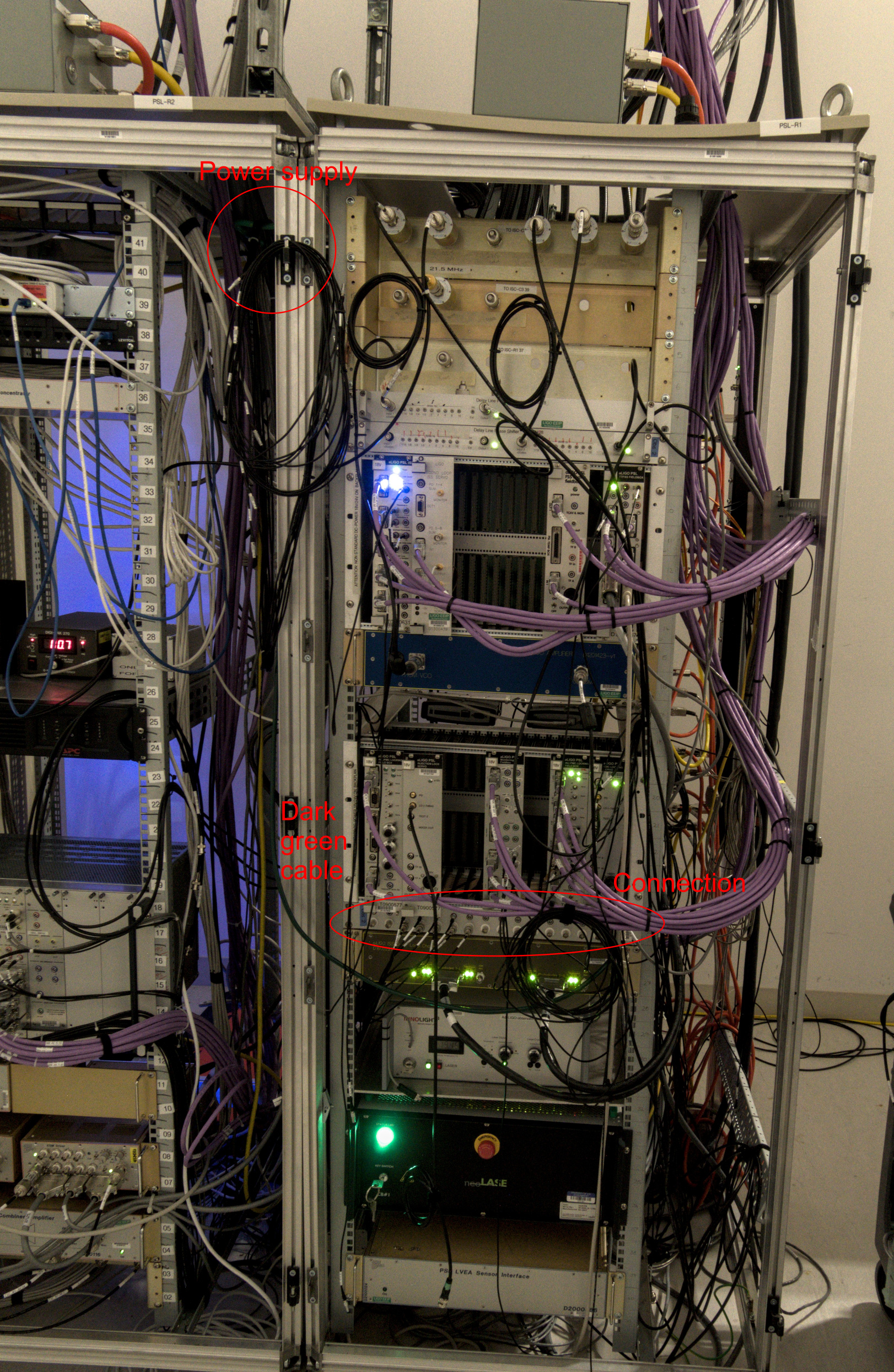 However, the comb did not appear as strong when we put the magnetometer besides the chassis where the cable leads.
On the other hand, the comb does appear strong if we follow the other dark green cable, that goes to this object
However, the comb did not appear as strong when we put the magnetometer besides the chassis where the cable leads.
On the other hand, the comb does appear strong if we follow the other dark green cable, that goes to this object
 Which Jason told us it may be related to the interlock system.
Following the white cables that go from this object, it would appear that they go into the coil, where we saw that the comb was very strong.
We think it would be interesting to see what here can be turned off and see if the comb does disappear.
Which Jason told us it may be related to the interlock system.
Following the white cables that go from this object, it would appear that they go into the coil, where we saw that the comb was very strong.
We think it would be interesting to see what here can be turned off and see if the comb does disappear.




